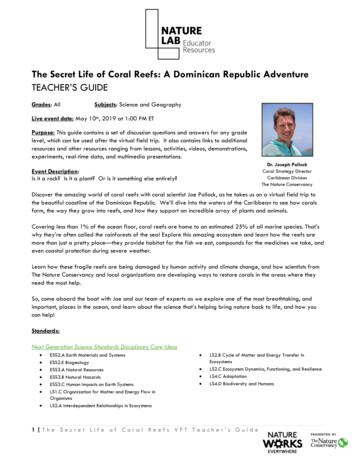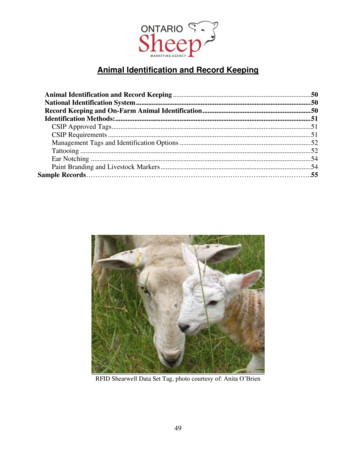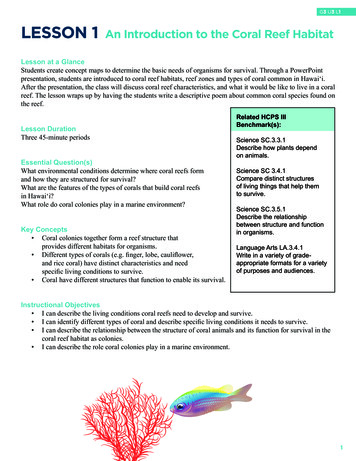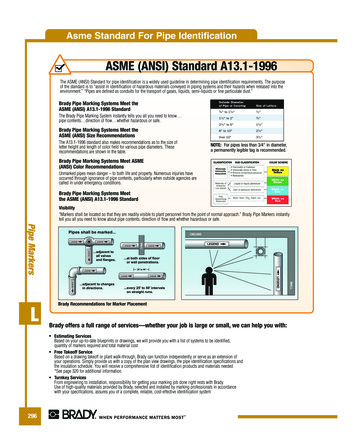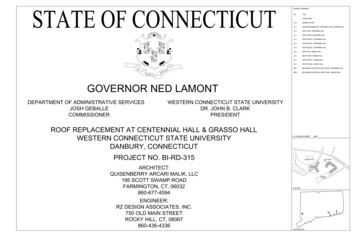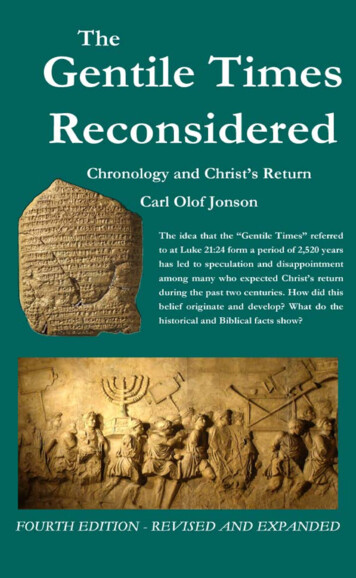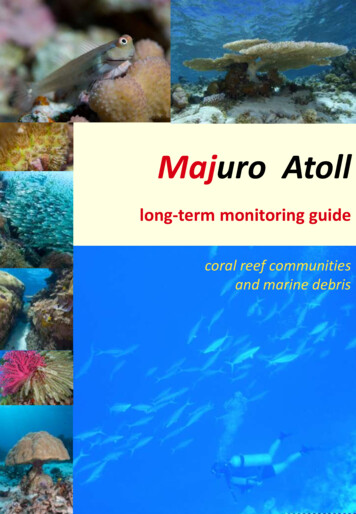
Transcription
Majuro Atolllong-term monitoring guidecoral reef communitiesand marine debris1
CONTENTS3. Background – why monitor?4. Survey Methods5. Survey Design Illustrated6. Counting Fish7. Survey Site Maps8. Site GPS Co-ordinates9. Coral Biodiversity Identification manual55. Coral Health56. Macroinvertebrate Surveys57. Holothurian Species Cheat Sheet59. Benthic cover datasheet60. Reef Fish data sheet2Cover Photos: Giles Winstandey and Silvia Pinca
WHY monitor ?Monitoring is important to measure change and enables aninterpretation of the success of conservation actions. Change canbe natural or forced by disturbance events. Change may be gradualand difficult to detect so quantitative data is needed.The method for measuring change in coral reef communities is theBACIR approach BEFORE AFTER CONTROL IMPACT REPLICATION.Changes are detected by measuring conditions before and after animpact. To detect changes with a necessary level of certaintyrequires control (unaffected) sites. To account for natural variation,replication is needed at the level of transect and site.3
Survey Methods2 depths @ each site3-5m & 8-10mReef FISH3 x 50m (2m wide belts – small reef fish)3 x 50m (5m wide belts – large reef fish)CORAL &RUBBISH Diversity3 x 50m ( 2m wide belts)* Includes inventory of rubbish within beltsLarge reef FISHBENTHICCover3 x 250m (5m wide belts)3 x 50m Point-intercept transects(100 points, record every 50cm)*includes counts of rubbishMacroINVERTebrates3 x 250m (5m wide belt)4** Remember 2 depths surveyed at each site 6 transects per site for all taxa.
Survey Design IllustratedReef Slope 8 – 10mThe deep sites are always surveyed first to ensure dive safety. Four weighted marker bouys aredeployed every 250m using a GPS to measure the distance. The coral and fish surveyor beginsurveying first starting at the second marker bouy and the large fish and invertebrate surveyorthen being their surveys at the first marker bouy. This strategy minimizes the disturbance ofsharks and large reef fish.Reef fish, coral biodiversity and PIT transects50mMarker bouy 450mMarker bouy 3250m50mMarker bouy 1Marker bouy 2250m250mLarge Reef Fish and macroinvertebrate transectsReef Crest 3 – 5mReef fish, coral biodiversity and PIT transects50mMarker bouy 4Marker bouy 3250m50m50mMarker bouy 2250mMarker bouy 1250mLarge Reef Fish and macroinvertebrate transectsNOTE: The reef fish biodiversity surveyor swims first while deploying the 50m transect tapes and is followedbythe coral biodiversity surveyor. After 3 transects, the coral surveyor swims first back along the transect conductingpoint-intercept transects and the fish surveyor follows winding up the tape.5
Counting FishReef Fish BiodiversityThe abundance and size of all non-cryptic fish species is documented on 3replicate 50m transects per habitat. Larger mobile fishes such as Wrasses,Parrotfishes, Emperors, Snappers, Surgeonfishes, Groupers, Butterflyfishes,Angelfishes are recorded on a 5m wide, and smaller site attached fishes(damselfish, small wrasses, etc.) on a 2m belt. This approach will ensure veryrigorous assessments of fish biomass and density, which is crucial fortemporal and spatial comparisons.Large Reef Fishes andSharksThe biomass and abundance oflarger, wide-ranging fish specieswith larger territories can be moreaccurately assessed on long swimtransects. Large fishes arerecorded at each site and depthon 3x250 m belt transect of 5 mwidth. Many of the speciesrecorded in these counts occur atsuch low densities that estimatesbased on smaller transects areimprecise and unreliable for ongoing monitoring.6
Long-term monitoring sites in Majuro Atolla). SCUBA sites on the reef crest and reef slope.b). SNORKEL sites from shallow lagoon sites.Specifically conducted to record marine debris.7
GPS co-ordinatesof long-termmonitoringdive sitesat MajuroGPS co-ordinatesof rubbishsnorkel sitesin Majuro Lagoon8
Coral Identification Training ManualHard Corals of theMarshall IslandsBy Dr Zoe Richards9
THIS HANDBOOK IS FOR TEACHING PURPOSES ONLY.PLEASE DO NOT DUPLICATE WITHOUT eksema, BW. 1989. Taxonomy, phylogeny and biogeography of mushroom corals(Scleractinia: Fungiidae). Zoologische Verhandligen Leiden 252, 1 – 295.Veron, J. and Pichon, M. 1976. Scleractinia of Eastern Australia. Part I. FamiliesThamnasteriidae, Astrocoeniidae, Pocilloporidae. AIMS Monograph Series. AustralianGovernment Publishing Service, Canberra.Veron, J and Pichon, M. 1980. Scleractinia of Eastern Australia. Part III. Families Agariciidae,Siderastreidae, Fungiidae, Oculinidae, Merulinidae, Mussidae, Pectiniidae,Caryophylliidae, Dendrophylliidae. Australian Institute of Marine Science MonographSeries. Australian Government Publishing Service, Canberra.Veron, J and Pichon, M. 1982. Scleractinia of Eastern Australia. Part IV. Family Poritidae.Australian Institute of Marine Science Monograph Series. Australian GovernmentPublishing Service, Canberra.Veron, J., and Pichon, M., and Wijsman-Best, M. 1977. Scleractinia of Eastern Australia. Part II.Families Families Faviidae, Trachyphylliidae. Australian Institute of Marine ScienceMonograph Series. Australian Government Publishing Service, Canberra.Veron, J and Wallace, CC. 1984. Scleractinia of Eastern Australia. Part V. Family Acroporidae.Australian Institute of Marine Science Monograph Series. Australian GovernmentPublishing Service, Canberra.Veron, JEN. 2000. Corals of the World. Vol 1, 2,& 3. Australian Institute of Marine Science,Townsville.Wallace, CC. 1999. Staghorn Corals of the World: A revision of the coral genus Acropora(Scleractinia; Astrocoeniina; Acroporidae) worldwide, with emphasis on morphology,phylogeny and biogeography. CSIRO Publishing, Melbourne.Wallace, CC and Aw, M. 2000. Acropora Staghorn Corals. A “getting to know you” andidentification guide. Ocean Environment, Sydney10Cover photos by Silvia Pinca, Maria Beger, Giles Winstanley and Jim Maragos
IntroductionThis coral identification training manual provides an introduction to the characteristics used toidentify scleractinian corals. It provides key-like summary descriptions of the most usefulcharacters used to distinguish between morphologically similar species. It includes a summaryand pictures of corals known to occur in the Marshall Islands. This manual is for teachingpurposes only and should be used in conjunction with other taxonomic sources (see referencelist, inside front cover).Identifying corals using this manualThis manual will guide the identification process, however, decisions about species boundariesshould always be made with reference to type or skeletal reference collections, as well assupplementary texts such as the AIMS Monograph Series (Veron et al. 5 Volumes 1976-1984),Corals of the World (Veron, 2000) and Staghorn Corals of the World (Wallace, 1999). Whenidentifying corals, it is most important to make consistent judgments about species boundariesand to be aware of the extent of variation that can occur within a species, particularly in differenthabitats. Examples of extreme morphological divergence may ultimately warrant classification oftaxa as new species, however such decisions should be made in the light of rigorousmorphological, biological, ecological and molecular analyses.AN INTRODUCTION TO CORAL TAXONOMYCoral taxonomy is based on the traditional, morphologically-based classificatory system. Newinformation from breeding and genetic research is beginning to challenge some of the currentgroupings. However, the current classification system provides a strong starting point fromwhich to test new hypotheses, particularly as the skeleton remains intact when the polyp diesand thus facilitates a good fossil record. Typically, species-specific tissue folding and Ca CO3precipitation produce consistent corallite features, hence skeletal characters have generallyprovided a reliable framework for classifying coral specimens.Many features of the skeleton are useful for identification purposes. Some of the maincharacters used include colony form, and the size and shape of corallites and their internalstructures (e.g. the presence/absence and size of columella). Other commonly used charactersinclude size, shape and arrangement of septa and costae, and the development of coenostealelaborations (e.g. size and arrangement of papillae and tuberculae are used to distinguish specieswithin the genus Montipora). Other useful skeletal characters will be discussed within sectionson each coral family.11
Key Characteristics of Cnidarians and Biology of CoralsScleractinian corals are Cnidarians, hence they share three characteristics with their close relativesthe anemones and jellyfish. First, they have tissue grade construction, whereby specializedcells are grouped into tissues that perform functions (e.g. mesenterial filaments digest prey),but tissues are not grouped into organs. Secondly, Cnidarians exhibit a diploblasticarrangement of tissues, whereby two epithelial cell layers (endoderm and ectoderm) areseparated by a connective layer called the mesoglea.Thirdly, unique to Cnidarians arecnidae or stinging cells in the epidermis. These cells contain everting intracellular organellescapable of stinging and entangling prey.Corals are modular organisms, hence they grow in size through replication of the module, knownas the polyp. Polyps replicate through budding and form colonies when daughter polypsremain attached. Because of the modular nature of colonies, corals are able to reproduceasexually through fragmentation, as well as through a variety of other mechanisms.Consequently, coral life cycles generally include both sexual and asexual phases. Spawning isthe most common mode of sexual reproduction and involves the release of eggs and sperminto the water column for external fertilisation. In hermaphroditic species, gametes (eggs andsperm) are bundled into packages held together by mucus in the hours before they arereleased. Once released, egg-sperm bundles ascend towards the sea surface, where theybreak apart and fertilisation occurs. Embryogenesis produces larvae called planulae. After anobligate 3-4 day period of planktonic development, larvae settle on appropriate substratumand metamorphose into the coral polyp, which founds a new colony. Scleractinian corals havea diverse range of growth forms, from single polyps to very large colonies that can live forhundreds of years.Most scleractinian corals form a symbiotic relationship with unicellular algae called zooxanthellae.Zooxanthellae live within coral tissues and provide a number of benefits for the coral host.One important benefit is the conversion of light energy into nutrients, some of whichsupplement the nutrition of the coral host.Tissue connections and within-colony communicationThe polyps within a coral colony are highly interconnected. In some corals, such as massivespecies in the genus Porites (below left), only a thin layer of living tissue covers the surface ofcoral colonies. In other groups, such as species of Acropora (below right), polyps communicatethrough a network of tissue connections that penetrate throughout the skeleton. 4mmAcropora polyp. Transverse section of acoral polyp with the skeleton removed.12Notice the tissue connections betweenpolyps that enable communicationand resource sharing.
Anatomy of the Coral Polyp and Structure of the Coral SkeletonA coral polyp is a sac-like animal that has a single opening, the mouth, which is surrounded bytentacles. The stomodeum connects the mouth to an internal space, the coelenteron, which iswhere digestion occurs. Inside the coelenteron, mesenteries radially divide the polyp andrepresent the surfaces over which nutrients are assimilated. Mesenterial filaments aredeveloped along the inner margin of the mesenteries and fulfill both a digestive functionwithin the polyp and a protective function when they are extruded outside of the polyp. Mostscleractinian corals are hermaphroditic, thus they contain both male and female gameteswithin the same polyp.Coral polyps secrete a calcium carbonate skeleton. The collective group of skeletal structures thathouse the polyp is called the corallite. The wall or theca defines the boundary of each corallite,though walls may be poorly developed in some coral families. The main structures within thecorallite are the septa, which are radial skeletal partitions supporting and separating themesenteries to facilitate nutrient assimilation. Paliform lobes may be developed on the inneredge of septa. Extensions of the septa outside the wall are called costae. When present, thecolumella is the tangle of spines formed where septa meet centrally in the corallite.Eggs beingreleased duringspawning.tentacleSperm being releasedoral discduring spawning.mouthstomodaeumcoelenteroncolumnmesentery containing eggsand spermseptacostaemesenterial filamentcalicewall cted gonads within a coral
Skeletal Elements of the Corallite (modified from Wood 1983)synapticulae(rods between septa)coenosteumexsert septum(raised over wall)insert septumsmooth septumseptal margin dentateseptal margin smoothgranulated septumporous septumcolumellasolid septumpaliform lobeSeptal characteristics are particularly useful for identifying some coral families. The numberof cycles of septa and the thickness of septa are useful characters for identifying favidspecies. The presence of a paliform crown is diagnostic for the favid genus, Goniastrea, andthe degree of paliform lobe development is useful for distinguishing other favid species. Theextent of septal exsertion over the corallite wall and development of septal dentation areimportant features for distinguishing between species in some families. Similarly, the shapeand development of the columella may also be diagnostic.Polyp Budding Used to help identify favid coralsExtratentacularBudding:Daughter polyp(and corallite)budded fromthe side ofthe parentpolype.g. in the genera Faviaand MontastreaIntratentacular Budding:Daughter polyp (and corallite) formedwhen parent polyp divides in twoe.g. genus Favites14
Colony Formation in Favid CoralsCerioid: walls shared between corallitesPlocoid: corallites separatefrom each other - walls arenot sharedPhaceloid: separateexsert polyps withextended wallsMeandroid: walls shared,valleys enclose many mouthsFlabello-meandroid: wallsnot shared; separate valleysenclose many mouths15
Coral Growth ched gitatecorymbose itose
Glossary of terms used in coral taxonomyarborescentBranching growth form in which equal sized branches divide in a tree-like manner.axial coralliteThe skeleton of the polyp that runs through the central axis of an Acropora branch, andhas its opening at the tip of the branch.axial polypThe polyp (living animal) that runs through the central axis of an Acropora branch andbuds radial corallites.basal plateThe skeletal base of the corallite that the polyp secretes and sits on.buddingDivision of a coral polyp to form daughter polyps, which modify or secrete new corallites;leads to colony formation.caliceThe opening of a corallite; defined by the wall.cochleariformA radial corallite shape in which the lower wall is expanded outwards and the upper wallis reduced.coenosteumThe skeletal structures between corallites; modified to form the corallite wall in Acroporaspecies.columellaCentral part of a corallite skeleton that can be rod-like or mesh-like.costaeSkeletal elements that are continuations of septa outside the corallite wall.coralliteThe skeleton of an individual coral polyp.corymboseShape of an Acropora colony in which the branches originate from a central growing pointand end in the same plane.costateForm of coenosteum consisting of ridges.dimorphismThe occurrence of two different forms of the same structure (e.g. axial and radial polypsare dimorphic polyps in the Acropora).ecomorphA habitat-related morphological variant of a species.labellateShaped like a lip (in radial corallites).nariformA character state of radial corallites whereby they are shaped like an inverted nose.papillaeCoenosteal structures on species of Montipora that are smaller than corallites.radial coralliteThe skeletons of polyps that are budded radially from the axial polyp, hence form thesides of an Acropora branch.septaThe vertical partitions of skeleton that radially divide the corallite.spinulesMinute spines on the coenosteum.synapticulaeHorizontal rods or bars connecting opposed faces of adjacent septa and perforating themesenteries between them.taxonomyThe process of recognizing, describing and ordering taxa.trabeculaeThe spines of crystal aragonite that form the septa and other processes that make 17up theskeleton of a polyp.tuberculaeCoenosteal structures on species of Montipora that are larger than corallites.
Family PocilloporidaeThis family contains abundant and widespread genera. Species are characterized by nodulargrowths on branches, corallite hoods or corallites aligned in rows. Internal skeletal structures ofcorallites are poorly developed. Often submassive or branching colonies. Common in allshallow reef environments.3 genera in RMI - Pocillopora, Seriatopora, StylophoraGenus PocilloporaverrucaeStunted branches with knobby growths (verrucae) cover colony surface. Corallitescover verrucae. Septa and columella poorly developed. Often grown in disturbedhabitats.Verrucae and branches intergrade - P. damicornisVerrucae do not intergrade with branchescolony with short compact branchesverrucae distributed uniformly on branchesverrucae longer than wide - P. verrucosacolony with elongate branchesveruccae longer than wide - P. indianaverrucae not longer than wide - P. eudouxiP. damicornisP. indianaGenus SeriatoporaFine branches, pointed tips - some branches fuse. No verrucae.Corallites in rows along branches. Coenosteum covered in finespinules.branches very fine ( 5mm diameter) - S. dendriticabranches 5mm diameterpointed branch tips - S. hystrixP. verrucosa (left) and P.eudouxi (right)rounded branch tipsbranches uptright, corallites aligned in clearrows with corallite hoods - S. caliendrumGenus Stylophorabranches prostrate, corallites aligned inindistinct rows an no corallite hoods Robust branches, seldom fusing. No verrucae.S. guttatausCorallites are hooded (only the upper wall isdeveloped). Corallites in rows along branchesElongate robust upright branches 5mm S. pistillataThin closely compactedbranches 5mm S. madagascarensisS. pistillataS.calendruim(left)& S. hystrix (right)S. hystrixThe corallite hoodis formed by thedevelopment18of the upper wallPocilloporid corals can show an extreme range of growth forms depending upon exposure and depth (i.e.sturdy in exposed environments and thin in deep or protected habitats).
Family AcroporidaeMembers of this family share the common feature of having few internal structures withincorallites.4 genera in RMI - Acropora, Montipora, Isopora, Anacropora, AstreoporaGenus AcroporaThe axial corallite is a diagnostic character of the genus and variation in the axial corallite formdue to differences in the number of synapticular rings can be used to distinguish betweenspecies. Acropora colonies develop from the extension of the axial corallite (or leading corallite)and the budding of radial corallites from the growing tip. The development of new axialcorallites and subsequent radial corallites leads to branching. However a great deal of varietyexists in morphological types. There are three basic categories used to identify Acroporacolonies - the growth form; the shape, size and arrangement of corallites; and the structure ofthe coenosteum (wall of the axial and radial corallites and the spaces in between). The numberand cycles of septa within the axial corallite and axial calice diameters are also useful characters.The peripheral radial corallites occur in a variety of shapes due to differences in walldevelopment. A gradation in corallite form can often be seen throughout a single colony andoften radial corallites on the colony margin and different from those in the centre of the colony.Some species are dimorphic (they have 2-sized radial corallites). The size, shape and inclinationof the corallite and the corallite opening are diagnostic characters. The number of radialcorallites per branch and their spacing are also useful characters.The genus Acropora has been divided into 16 species groups accordingto their colony form and radial corallite shapeSpecies groupColony formRadial corallite shaperudisarborescentthickened, rounded , small openingshumilisdigitatethickened tubular, dimidiate openingsnasutacorymbosenariform or tubo-nariformdivaricataplate, central or side attachedthickened nariformmuricataarborescent or arb. tabletubularfloridahispidosethickened appressed tubularrobustasubarborescentdimorphic labellatelovellivariousappressed tubular, round openingsverweyicaespito-corymboseappressed tubularselagovariouscochleariformasperacorymbose or arborescentlabellatehyacinthustables or pressed tubular19tubular with round openingsloripeshispidose or corymboserounded appressed tubularechinatahispidoseappressed tubular
Radial coralliteshapes of Acropora speciesa. tubular with round opening;b. tubular with oblique opening;c. appresed tubular;d. tubular with dimidiate opening;e. tubular with nariform opening;f. rounded tubular;g. nariform with elongate opening;h. nariform with round opening;i. labellate with rounded lip;j. labellate with flaring lip;k.labellate with straight lip;l. cochleariform;m. appressed tubular;n. conical;o. subimmersed;p. immersed.20
rudis groupaustera- sturdy irregular arborescent colonies with medium-sized branches, obvious thick roundradial corallites. May grow in thickets and ‘fill in’ space on reef tops and slopes. Occurs in shallowexposed locations especially upper reef slopes.A. austerahumilis groupdigitifera -small digitaate colonies with evenly sized andspaced branches. Radial coallites are lipped tubes radialcorallites can be different sizes, branches thinnest of humilisgroup. Occurs on reef flats.gemmifera- sturdy corymbose colonies with conicaltapering branches. Radial corallites have two sizes. Axialcorallites are small. Occurs in shallow exposed locations.A.digitiferahumilis - corymbose colonies with terete conical branches.Radial corallites are evenly sized and the axial corallite is verylarge. Occurs in shallow locations.A. gemmiferaA. humilissamoensis- irregular corymbose colonies with lots ofbranching. Well spaced radial corallites face outward frombranch. Occurs in deeper habitats than other species from thehumilis group.monticulosa- sturdy corymbose colonies with conicalbranches that have square bases. Axial and radial corallites are allthe same small size. Reef flats.A. retusaA. samoensisretusa - low sturdy corymbose colonies with radial corallitesof mized sizes. Radial corallites are dimidiate or tubular withdimidiate openings and touching on the branch. Occurs onsubtidal reef flats, usually brown in colouration.21A. monticulosa
nasuta groupnasuta - flat corymbose colonies, branches taper, radial corallites evennariform. Reef edge and slope.cerealis- corymbose colonies with thin terete branches. Radialcorallites are long and tubular with an elongate opening and upwardfacing lip. There may be some anastomosis. Grows on reef flats, slopesand walls - usually one of the finest of the corymbose species.valida- corymbose colonies with thin branches and tubular radialcorallites that are appressed to the branch. Often dull brown in colour.Common on the reef slope and crest.A. nasutaA. cerealiskimbeensis - Fine branches, proliferating at the tipsecale -sturdy corymbose colonies with thickwalled dimorphic corallites with elongate openings.Grows in shallow reef habitats.A. secalelutkeni -irregular sturdy branches, radialcorallites irregular tubes. Often blue, Grows on reefflats.A. divaricataA. validadivaricata groupdivaricata- Rounded or flat-topped clumps with adistinctive divergent branching pattern. Radial corallites areevenly sized and tubular with broad nariform openings. Theupper surface of branches may be bare.A. divaricataclathrataFlat tables with lots of flattened and fused branching. Radialcorallites may be mixed sizes or nariform with appressed tubonariform corallites. Occurs on reef tops, slopes and walls to 20m.A. clathrata22Storm-damaged A. clathrata
muricata groupmuricataarborescent colonies with many tightly packed narrow tubularradial corallites with oval openings.grandissturdy arborescent colonies with dimorphic radial corallites. Radialcorallites are tubular with big round openings. Radial corallites canbe longer at the tip and the skeleton of these corallites is veryporusmakingthetipsverydelicate.A. muricataacumiataarborescent table, usually small coloies with fused slenderhorizontal branches. Branches may curve upwards.Radialcorallites lipped and some may be very long.A. grandisvalencinessiarborescent table with can form very large colonies. Branches arelong widely separated and upwardly curving. Radial corallites areeven giving the branch a smooth appearance.A. acuminataA. valencinessisA. muricata- Drupella scarsflorida group.A. sarmentosasarmentosafloridaA. floridaarborescent table with sturdy branches and smallbranchlets forming a rosette. Large radial coralliteswith round lips and small axial corallites. Grows inmostcoralreefhabitats 20m.‘dinner plate’ with sturdy branches and smallbranchlets forming a rosette. Large radial23 axialcorallites with round lips and smallcorallites.Grows in most coral reefhabitats 20m.
robusta grouprobustairregular arborescent colonies with dimorphic radial corallites.Peripheral branches curving. Shallow exposed locations. Oftendistinctive green with pink tips.abrotanoidesA. abrotanoideslots of branching at tip of arborescent colony,A. robustaradial corallites are long, tubular andsubimmersed. Grows on shallow reef topsand crest.intermediaarborescent colonies with clearly dimorphiccorallites. Radial corallites tubular withdimidiate openings.Features straightbranches that are borne at wide angles. Allcoral reef habitats to 18m.A. abrotanoidespolystomairregular short branches with tubular radial corallites with anelongate lip.Similar to A. abrotanoides and A. isteri.A. intermedialisteriirregular clumping and tapering branches. Radial corallites aredimorphic. Some branches may be very long. Grow on the reefcrest.lovelli groupA. polystomaglaucacorymbose plates or clumps with terete branches with may flattenout as anastomosed plates. Radial corallites are evenly distributed,equal shapes and sides, appressed rounded tubular with large roundopenings. Quite strong septal development distinguishes this speciesfrom A. solitaryensis.A. glaucabranchiflat highly fused solid plates that may grow in tiers. Axial corallites areusually distinct, some colonies have short upright branchlets.Corallites have a thick wall. Usally dark green in colouration. Similarto A. glauca but this species usually has more branchlets.verweyi groupA. branchiverweyioccurs in small clumps with short thin branches and large thickenedradial corallites with roiund openings. Occurs on the reep top andcrest.24A. verweyi
selago groupselagofine corymbose colonies with even lipped radial corallites. The polyphas a dark centre when withdrawn during the day. Grows in lagoonsand on slopes.tenuiscorymbose colonies with compact branches, and radial corallites witheven lips. Occurs in shallow coral reef locations.A. tenuisyongeiarborescent colonies with frequent branching, and lipped radialcorallites.Occursonreeftopsandslopes.A. yongeistriataupright hispidose colonies. The terminal branches may fan out.Radial corallites are lipped. May form large tree-like colonies.Occurs on slopes and in lagoons.A. milleporaA. striataaspera grouppulchraarborescent colonies with radialcorallites with a pointed lip, most nottouching with a mixture of sizes. Innerreef flat.A. pulchramilleporaeven corymbose colonies with denselypacked slender branches that appearsmooth dure to the large lipped radialcorallites. Occurs in a variety ofcolours depending upon symbionts.Occursonreefflats.25A. millepora
hyacinthus grouphyacinthusplate coral with upright branchlets that form a rosette-like pattern. Radialcorallites have a flaring lip and the axial corallite is short. Grows on the reef topor slope.A. hyacinthusanthocercisplate with an irregular colony surface due to exsert incipient axial corallites.Radial corallites have a flaring lip. Grows intertidally and on exposed outerflats and patch reefs.cythereaA. anthocercisplate with a flat-top and radial corallites that are elongate with an upwardpointing lip. Crumbly to the touch due to lightly calcified radial corallitesAxial corallites are elongate. Occurs on slopes or submerged reefs.lamarchi( New species in Veron 2000 - not a formal member of hyacinthus group).Plating colonies with thick tapering branches that are longer and inclinedtowards the colony margin. Often grows as tiered plates. Axial corallitesslightly exsert and radial corallites tubular and pressed against the branchwith an open lip. Distinct from A. hyacinthus because it lacks a distinct axialcorallite and ‘rosette’ pattern of radial corallite arrangement. Separatedfrom A. cytherea due to the thick and inclined branches. Grows on theuppperreef slope.A. cythereaA. lamarchilatistella grouplatistellaflat corymbose colonies or thickplates with short thin verticalbranches that are closelycompact. Can be a range ofcolours. Occurs in silty locations.A. nanaA. latistellaaculeusflat corymbose colonies, shortslender vertical branches, radialcorallitestubular,round,appressed to branch. Grows to20m
One important benefit is the conversion of light energy into nutrients, some of which supplement the nutrition of the coral host. Tissue connections and within-colony communication Acropora polyp. Transverse section of a coral polyp with the skeleton removed. Notice the tissue connections between
